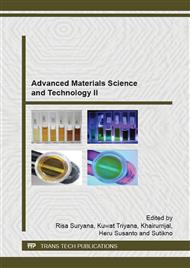p.289
p.295
p.303
p.308
p.312
p.316
p.325
p.329
p.333
In Vitro Release Characteristics of Hydrophobic Breast Cancer Drug Loaded Poly Lactic-co-Glycolic Acid (PLGA) Nanoparticles
Abstract:
The present work focuses on the development of biodegradable PLGA nanoparticles (NPs) for controlled release of a breast cancer drug, letrozole. NPs of different drug-polymer ratio formulations (F1, F2, F3, F4) were fabricated using solvent evaporation technique. Physico-chemical characteristics of these NPs were assessed using dynamic light scattering (DLS) spectrophotometer. In-vitro drug release study was carried out over an extended period of 30 days at 37 °C in simulated physiological fluid. To evaluate the release kinetics, data was fitted to different models. NPs with various sizes and size distributions were obtained by altering the drug-polymer ratio. Zeta potential of PLGA and drug loaded NPs were found to be-29.4± 1.3 mV and-21.0±0.6 mV, respectively. The release kinetics of the drug from NPs was in good agreement with Korsmeyer-Peppas model, ensuring controlled release of the drug from the NPs. In-vitro release studies showed high correlation coefficient (R2 = 0.90) for formulation F2 and F3 up to 30 days. It is concluded that NPs with F2 and F3 formulations provide a controlled release of the incorporated drug and, therefore, hold promise to be investigated further in detail.
Info:
Periodical:
Pages:
312-315
Citation:
Online since:
August 2015
Authors:
Keywords:
Price:
Сopyright:
© 2015 Trans Tech Publications Ltd. All Rights Reserved
Share:
Citation:


